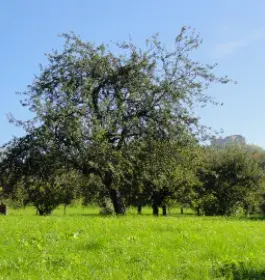The biodiversity of an orchard
Like a good neighbour, the orchard is a treasure trove of biodiversity, where numerous species come together to help make fruit trees the little treasures we love so much.
Whether they stretch as far as the eye can see or just span the bottom of your garden, thousands of trees or just the two, providing perfect shade for a summer nap, orchards are a bit like an iceberg – the visible fruit trees are only a tiny fraction of what’s really going on beneath the surface. Herbs, plants and insects, all their exchanges bubbling up into a healthy ecosystem. But beware the excesses of intensive farming and the depletion of these biodiversity hotspots.
Orchards, a celebration of biodiversity
Orchards can take various forms, each with their own unique biodiversity:
- Traditional orchards, with their spaced-out trees that glisten under the sun, are home to grassy meadows and wild plants. From the microfauna that live on the surface of the soil to the pollinating insects that forage from flower to flower, the biodiversity found here is one of the richest in the world. Common sights in Mediterranean countries, from apple trees in Normandy to mirabelle plums in Lorraine, their cultivation is now in decline;
- Conservation orchards, where the goal isn’t to grow fruit to sell, but rather to protect the species that live there. They’ve been established in many regions to conserve endangered local heritage. Most often, you’ll find very old varieties planted here. They’re a type of living history, rich in diversity;
- Kitchen garden orchards typically include a small number of fruit trees that grow alongside vegetables in the garden. Many beneficial exchanges take place between these two ecosystems. They form a harmonious biosphere, which attracts lots of species, provided crop diversity is given pride of place;
- Commercial orchards, designed to grow fruit for sale. In the interests of productivity, these are the most likely to have shifted away from traditional cultivation methods towards intensification. Mechanisation, phytosanitary processing, monocultures... this is the agricultural method where biodiversity is most at risk.
What does an orchard contain?
Fruit crops include both “productive” species, i.e. the fruit trees themselves, and “resource” species, which are essential to an orchard’s survival.
These are known to encourage pollination by attracting foragers. Bees, bumblebees and butterflies all love the hazelnut, plum, ivy, bramble and willow trees that form protective hedges around orchards. They also like the weeds that grow in the shade of the fruit trees, such as dandelions and clovers. Field roses, hawthorn and buttercups are all but guaranteed to be found in abandoned or poorly tended orchards.
Resource species also help control pests, preserve the soil between two fruit harvests and contribute to the decomposition of plants, which enriches the soil. Orchards where little human intervention takes place are rich in mosses, lichens and mushrooms. These are essential to balance out the ecosystem.
In orchards, the presence and variety of “resource” plants depend on how and to what extent the orchard is managed. The biggest cause of poor species diversity is usually intensive and specialised farming.
Orchards in danger
When sustainable agriculture is set aside for intensification and specialisation, fruit production within an orchard can represent a real threat to biodiversity and, in the long term, even deplete crops.
To keep producing more and more, orchards increasingly concentrate more individuals of the same fruit species to the detriment of variety. This technique impoverishes exchanges between species, limits the expansion of biodiversity and weakens the balance of the ecosystem. Diversity is a formidable weapon against parasites and diseases, since it dilutes their impact by boosting the genetic makeup of the ecosystems they attack.
Specialisation can be compounded by mechanisation, which itself poses a real threat to the soil and “resource” plant species. Hedgerows and natural borders, which are home to many permanent species but also serve as resting places for lots of other birds, are often destroyed, impoverished or artificially recreated.
Intensification also increases the need for water. To satisfy a never-ending thirst, water is drawn from the water table, which can run dry and take longer and longer to replenish if not managed sustainably, jeopardising the hydration cycle of all the crops in the area.
When an ecosystem is knocked off balance, species are put at risk. The decline in plant and animal biodiversity also has consequences for productive species, in other words, the fruit itself. Increasingly fragile, they’re more sensitive to their environments, climate variations, meteorological phenomena, parasites, etc. This creates a vicious cycle. To compensate for the imbalance in the ecosystem, farmers may be tempted to use phytosanitary products (fungicides, pesticides, insecticides), which only serve to destroy even more biodiversity, instead of restoring it and allowing it to play its proper role.

Encouraging biodiversity with high-stem orchards
The high-stem orchard, pre-orchard or eco-overgard is a method inspired by the traditional orchard. The principle is to combine fruit trees with grassland, at a limited density. This studied proximity encourages the multiplication of plant species - herbaceous plants, buds and flowers, dead wood, etc. - and animal species, which come here to find shelter, support and food. A high-stemmed tree is a fruit tree grafted at a height of two metres onto a rootstock that gives it strength and resistance. Combined with other types of crops or livestock, these orchards provide essential services such as protection from wind or erosion, contributing to soil quality, offering denser grazing... They can therefore be set up in any type of environment to enrich its biodiversity!

Biodiversity is all around us!
Find out more about river biodiversity
